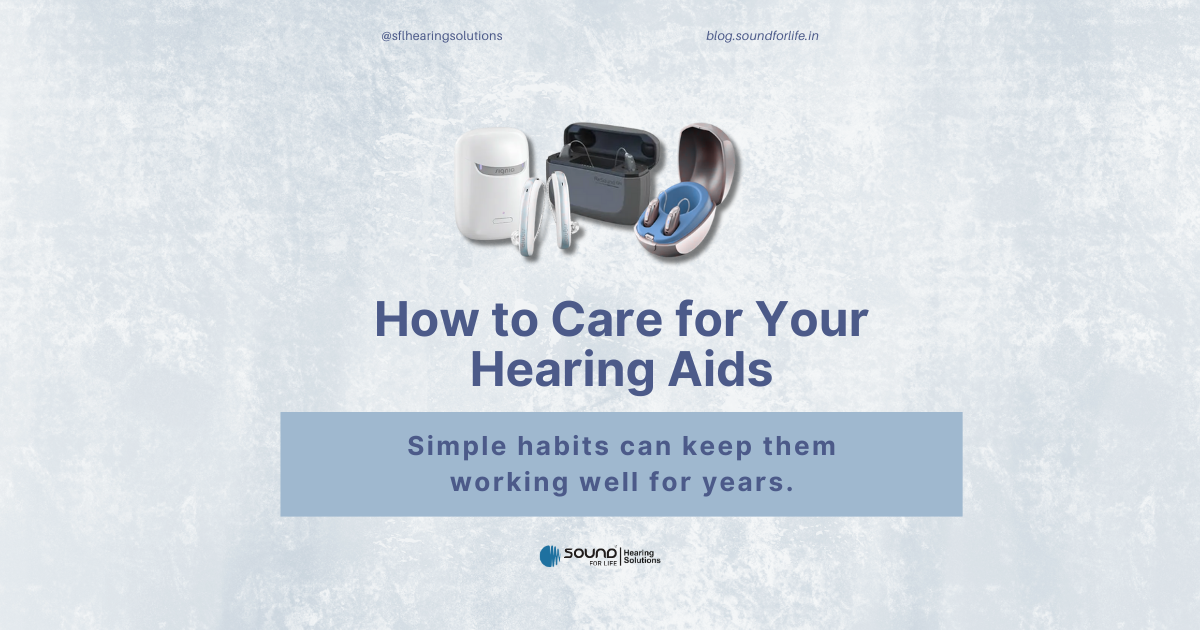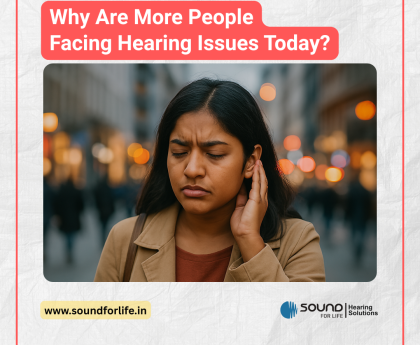You might be surprised to learn how simple it is to maintain your hearing aids. By following a few simple tips regularly, your hearing aids can keep working well for many years. The same general guidelines apply whether your device fits in your ear (ITE/ITC) or rests behind your ear (BTE). Frequent cleaning and careful handling preserve the sound and safeguard your investment. This handbook explains the importance of care and provides you with daily, weekly, or monthly routines to follow.
Why Hearing Aid Care Is Important
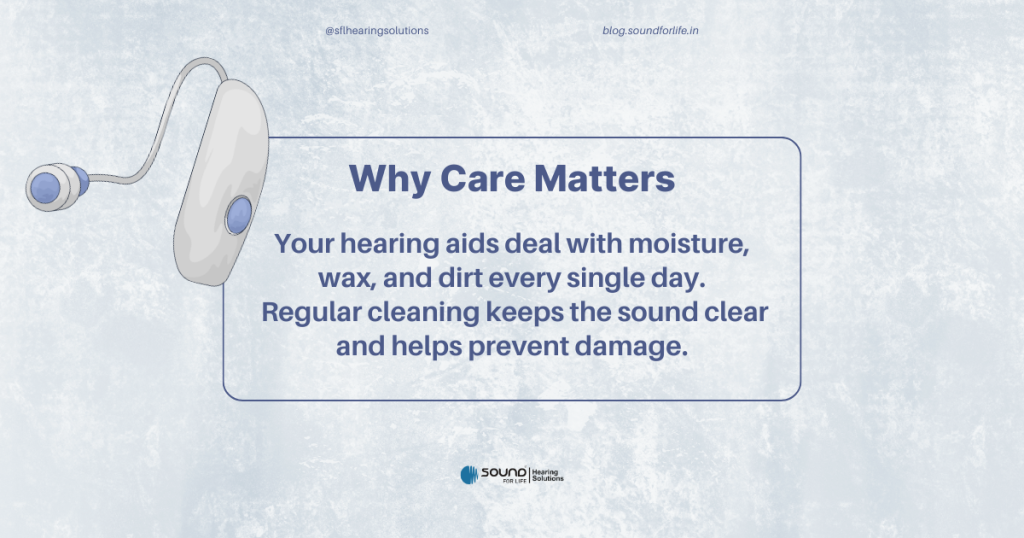
Hearing aids are small, delicate devices that work inside the ear canal. To improve your hearing, they pick up sound and make it louder. Since they reside in your ear, they face moisture, wax and dirt every day. If we do not clean them regularly, wax and moisture might accumulate inside it. This accumulation might produce whistling and feedback or make sound appear dull. In fact, wax clogging is one of the most common reasons hearing aids stop working properly. You can achieve the greatest sound quality and prolong the life of your hearing aid by cleaning it daily. Think of daily care as part of protecting your hearing investment, it helps you hear clearly now and for years to come.
Basic Daily Maintenance
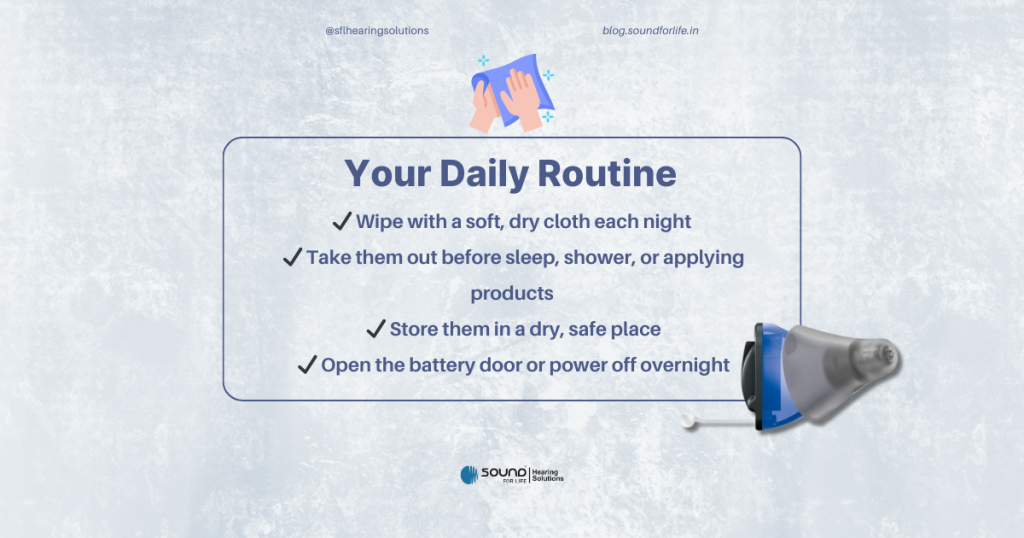
Make these simple steps part of your daily routine, just like brushing your teeth or washing your face:
● Wash your hands first. Always start with clean, dry hands. This prevents dirt or germs from getting on your hearing aids.
● Wipe and brush gently every night. At the end of each day, use a soft, dry cloth and the tiny brush or tool that came with your hearing aids. Gently wipe the body of the hearing aid and any earpieces. Use the brush to sweep away any visible wax or debris from the tiny openings and the tube. This will help prevent muffled sound or feedback.
● Remove them at bedtime. Take your hearing aids out before you go to sleep. This gives them time to air out and dry, which helps avoid moisture damage. Many people find it easy to store them in a safe spot at night when they take them out.
● Turn them off or open the battery door. If your hearing aids have disposable batteries, open the battery compartment and/or turn off the device overnight. This saves power and lets any moisture inside dry out. (Always follow your audiologist’s instructions about batteries.)
● Keep them dry and chemical-free. Remove your hearing aids before showering, bathing, or swimming. Also take them out before using hairspray, hair gel, or applying lotion and sunscreen around the face – let those products dry first. Water and chemicals can damage the electronics. (Never use an alcohol wipe or cleaning liquid on the device.)
● Store them in their case or charger when not in use. Keep hearing aids in a protective case or on their charger any time you’re not wearing them (including at night). This protects them from dust, drops, and curious fingers.
● Avoid heat and cold. Don’t leave hearing aids in very hot or cold places, like in a car on a hot day or in freezing temperatures. Extreme temperatures can warp the plastic and damage the electronics. When going outside in winter or doing yard work, take off your aids and put them in a safe spot at home.
Following these daily steps will help keep your hearing aids clean and working reliably each day.
Weekly and Monthly Cleaning Tips
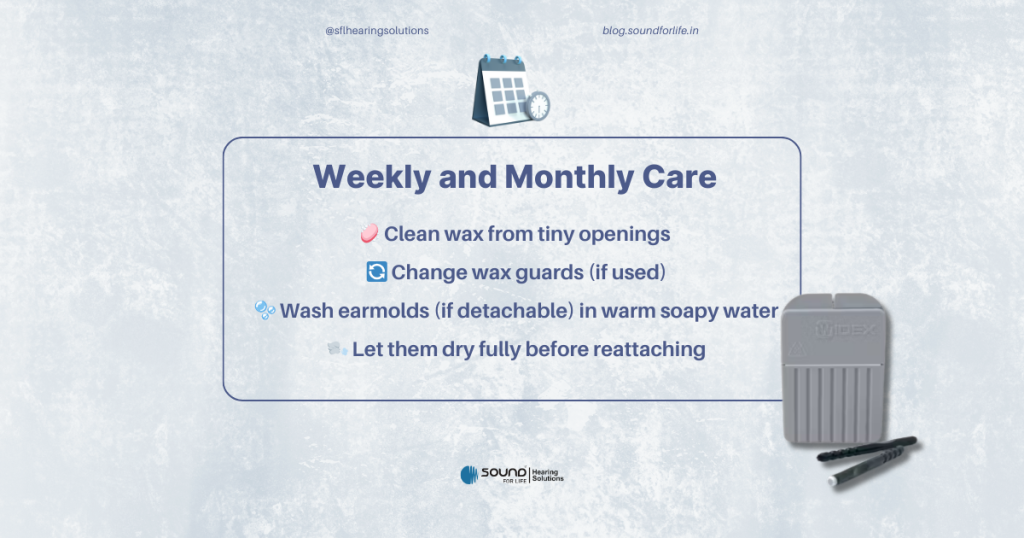
Once a week (and monthly for some parts), do a deeper cleaning to keep your aids like new:
● Brush out earwax. Even with daily cleaning, some wax or debris can collect in tiny places. Use a small brush or wax pick to reach inside the openings where sound comes out and the microphone enters. It helps to hold the aid so the opening points down, letting any loose bits fall out. Change any small wax guards or filters (if your aid has them) about once a month.
● Clean behind-the-ear (BTE) models: If you have a BTE hearing aid (with a tube and earmold), detach the earmold from the hook each week. If the earmold does not contain the tiny speaker, you can wash just the earmold in warm, soapy water. Rinse it well, then blow water out of the tubing with a small bulb or blow gently (as if cleaning a straw). Let it dry completely overnight before reattaching. (Never put the electronic part of the hearing aid itself in water.) Also wipe or replace the soft dome tips at the end of the tube every 1–2 months.
● Clean in-the-ear (ITE/ITC) models: If your hearing aid fits entirely in the ear canal (ITE or ITC style), do not wash it with water. Instead, use the brush and pick each week as above. Gently clear wax from the sound outlet. Remember to change the wax guards monthly if your aid has them. Finally, wipe the outside of the aid with a soft, dry cloth; never soak it.
● Use a soft cloth for finishing. After brushing or washing, use a clean, dry microfiber or soft cloth to wipe the entire hearing aid. This removes any dust or moisture from the outside. A quick nightly wipe can become a weekly habit for extra cleaning.
● Never submerge the electronics. Hearing aids should never be soaked in water or placed in liquid. Water can ruin the mic and speaker parts. Only removable, non-electrical parts (like earmolds or domes) are safe to wash.
● Consider extra drying in damp weather. If you live in a humid climate or sweat a lot, run a dehumidifier or hearing-aid dryer box overnight. These devices pull moisture out of your aids to prevent rusting and corrosion. Even if it seems fine, drying every night can add years to your device’s life.
Weekly cleaning may seem like extra work at first, but most steps become quick habits. Over time your hearing aids will be almost free of wax and moisture, which means better sound for you.
How to Handle and Store Hearing Aids
Handling and storing your hearing aids safely will prevent accidents and damage. Use these friendly tips:
● Stick to a safe routine. Take off your hearing aids at roughly the same times each day (for example, at bedtime and when showering) and always put them back in the same spot. This way you won’t misplace them. Good spots include a bedside table, a dresser, or a special drawer. Avoid random hiding places – consistency is key.
● Keep them in a protective case. When you aren’t wearing your hearing aids, store them in their hard case or charging base. This shields them from falls, dust, and curious pets or children. If you carry them in a purse or pocket, keep them zipped up in their case.
● Avoid unsafe locations. Never leave hearing aids on the bathroom sink, on a sunny windowsill, or in a hot car. Bathrooms and cars can be damp or very hot, which harms the electronics. Don’t store them in the refrigerator or freezer either – cold can damage them.
● Keep them out of reach of kids and pets. Hearing aids and batteries are very small and can be swallowed by a child or pet. Always store your hearing aids (and spare batteries) in a place children and pets cannot reach. If someone accidentally swallows a hearing aid or battery, call a doctor right away – button batteries especially can cause serious injury.
● Use a dehumidifier or dry box if needed. If humidity is a problem (for example, in a bathroom, basement, or in very humid weather), keep your hearing aids in a drying box or dehumidifier each night. These devices have a desiccant or electronic drying cycle to absorb moisture. (Some charging stations even include a drying feature.)
● Handle with gentle care. Treat your hearing aids like the delicate instruments they are. Do not drop them on hard floors, sit on them, or expose them to water. Always put them in place and take them out carefully – using both hands if needed.
By storing your hearing aids wisely and handling them gently, you avoid many common problems (like crushed tubing or water damage) before they happen.
Battery Care and Charging Tips
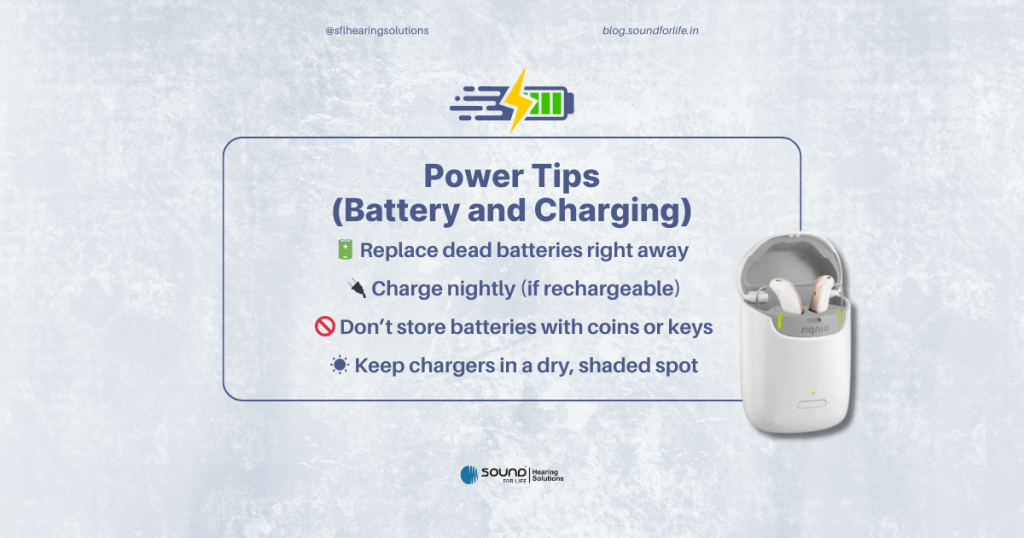
Whether your hearing aids use disposable batteries or are rechargeable, proper battery habits are important:
● Disposable (single-use) batteries:
○ Change batteries as needed. Replace a dead battery right away to avoid static and to always have clear sound. Keep a small supply of extra batteries at home.
○ Open the battery door overnight. Every night, open the battery compartment and remove the battery (or turn the aid off) so that any moisture inside can evaporate. This also saves battery life.
○ Store batteries safely. Keep unused batteries in a closed container at room temperature – never in the fridge. Do not mix batteries with coins, keys, or other metal (they can short out). Keep them away from children and pets; button batteries can be lethal if swallowed.
○ Dispose of old batteries properly. Put used batteries in a sealed, child-proof container and take them to a recycling drop-off or safe disposal site. Do not toss them in the trash where a child or pet might find them.
● Rechargeable hearing aids:
○ Charge every night. Place your hearing aids on their charger base each night as directed, even if the battery indicator still shows power. This ensures they start the next day fully charged. Many experts recommend letting them charge after every use.
○ Follow the manufacturer’s instructions. Use only the charger that came with your aids, and plug it into a reliable outlet. Keep the charging station in a dry, safe spot (on a table or shelf). If your hearing aids get sweaty or damp during the day, wipe them dry before charging.
○ Avoid battery drain if possible. Try not to let rechargeable aids sit completely dead for long periods. Regular charging and use will help the battery last longer over time. If you’ll be away from the charger for a while (like traveling), make sure they are fully charged before you go.
By caring for your batteries (whether replacing or charging) and storing them safely, you avoid many hearing aid problems. Always remember: “Button” batteries are extremely dangerous if swallowed, so keep them secured.
When to See a Professional
Even with the best home care, hearing aids need occasional professional attention. Your hearing care provider has special tools and expertise to keep your aids in top shape. Here’s when to make an appointment:
● Regular check-ups: Plan to have your hearing aids professionally cleaned and checked about every 6–12 months. Audiologists use tiny vacuums and brushes to remove wax and debris from inside vents and microphones (places we can’t reach at home). These visits catch small issues early.
● If sound changes or trouble begins: If your hearing aids start sounding weak, distorted, or whistling (feedback) even after you’ve cleaned them, see your specialist. These can be signs of wax build-up or a need for a new filter. If the device won’t turn on or gives no sound at all, it may need repair. Don’t ignore these problems – a quick trip to your audiologist can often fix them.
● After damage or injury: If your hearing aid is dropped hard, gets very wet, or if you develop an ear infection, take the aid in to be checked. Even a little moisture can corrode the inside, so a professional drying or repair might be needed. If you have ear pain, redness, or a bad odor coming from the aid, have a health professional examine your ear too.
● For adjustments and updates: Sometimes your hearing changes, or the aid needs fine-tuning. If sounds seem too loud or too soft, or if you get discomfort, schedule a visit. Your audiologist can reprogram the device or reshape the earpiece for a better fit.
Remember: professional care is part of the routine. Getting your hearing aids checked twice a year and asking for help whenever something is wrong will keep them running smoothly.
Common Mistakes to Avoid
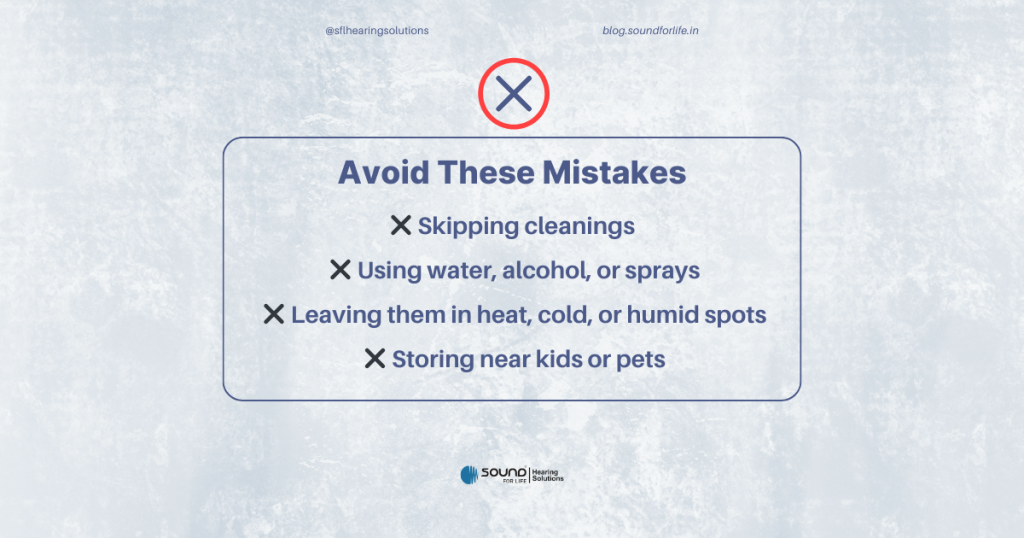
Even well-meaning users can slip up sometimes. Here are common pitfalls and how to avoid them:
● Skipping cleaning. Letting wax, dust, and moisture sit on your hearing aids will quickly dull the sound or cause whistling. Don’t put off your daily wipe-down and weekly brush. A little cleaning goes a long way.
● Using water or harsh chemicals. Never immerse your hearing aids in water, or use alcohol, hair spray, or household cleaners on them. Water and chemicals can kill the
tiny microphone and speaker in seconds. Only use the tools and cloth provided.
● Wearing them in water. Do not wear hearing aids in the shower, bath, hot tub, or pool. The steamy bathroom is risky too. Even tiny droplets can creep into the device. Always remove them when around water.
● Exposing them to extreme temperatures. Heat and cold are harmful. Avoid wearing your aids in a sauna or leaving them on a beach chair. Similarly, don’t let them sit in a cold car overnight. Extreme weather can warp or crack the plastic and break electronics.
● Using your fingers or hard tools. Be gentle! Don’t poke the microphone or speaker openings with fingernails or sharp objects. Use the soft brush or pick designed for the job. Poking can permanently damage the mic or receiver.
● Not following up with your audiologist. Hearing aids often need small tweaks and cleanings at the clinic. Skipping those appointments can lead to irritation, poor sound, or even ear problems. Always keep up with your scheduled visits.
● Ignoring battery signs. If your hearing suddenly mutes or crackles, don’t assume the aid is broken—check the battery first. A fresh battery (or full charge) solves many problems.
● Giving up too soon. It takes time to get used to new hearing aids. Don’t let a little feedback or adjustment period discourage you. Stick with these care steps and consult your audiologist if you have concerns. Your hearing aids are there to help you – work with them patiently.
By avoiding these mistakes, you’ll save yourself headaches and keep your hearing aids in good condition. Small efforts in care make a big difference in performance.
Final Tips for Long-Lasting Hearing Aids
● Make caring for your hearing aid a habit. Just like wearing glasses, cleaning and checking your hearing aids each day becomes second nature over time. For example, wipe them off before bed and put them somewhere dry. These little routines add up to many years of good use.
● Remember professional help. Regular check-ups (every 6–12 months) will catch problems early. Don’t hesitate to call your audiologist with any questions.
● Be patient and positive. It may feel like a lot at first, but most of these steps only take a few minutes. Proper care really pays off. “Proper cleaning and maintenance will help you get years of trouble-free wear with your hearing aids”.
● Enjoy clearer hearing. When your hearing aids are clean, dry and working well, you’ll notice the difference: better hearing, fewer frustrating sounds, and the chance to stay connected to family and friends.
Taking care of your hearing aids is easy once you get into the habit. A friendly daily check and a few simple cleaning steps will keep your hearing aids comfortable and reliable. With this simple routine, your devices can keep giving you clear sound and confidence every day.
Sources: Tips here are based on best practices from hearing health organizations and audiology experts.

